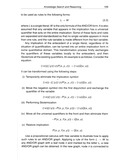![人工智能:探昔论今 《人工智能:探昔论今》[42M]百度网盘|pdf下载|亲测有效](/downpdf2/uploads/s0309/df4797dbec9b771a.jpg)
![《人工智能:探昔论今》[42M]百度网盘|pdf下载|亲测有效](/downpdf2/uploads/s0309/df4797dbec9b771a.jpg)
人工智能:探昔论今 pdf下载
内容简介
本篇主要提供人工智能:探昔论今电子书的pdf版本下载,本电子书下载方式为百度网盘方式,点击以上按钮下单完成后即会通过邮件和网页的方式发货,有问题请联系邮箱ebook666@outlook.com
编辑推荐
(1) 《Artificial Intelligence:From Beginning to Date》 comprehensively covers the technical content of artificial intelligence. It not only discusses knowledge-based artificial intelligence with a certain space, but also highlights data-based artificial intelligence content with a larger space, so that readers have a more comprehensive understanding of artificial intelligence from ancient times to the present.
(2) 《Artificial Intelligence:From Beginning to Date》focuses on the new technology of artificial intelligence that has been rapidly developed and widely used in recent years. It provides a relatively comprehensive introduction to deep neural networks and deep learning and their applications, which can be used as a research guide for readers to learn and refer to.
(3)In addition to discussing the technical content of artificial intelligence, 《Artificial Intelligence:From Beginning to Date》discusses on some general issues of artificial intelligence in the new era, such as the core technology and role of artificial intelligence, industrialization of artificial intelligence, the benefits and safety of artificial intelligence, which will help readers expand their horizons and enhance their comprehensive understanding of artificial intelligence.
内容简介
《人工智能:探昔论今(英文版)》涵盖了人工智能的广泛领域。首先,《人工智能:探昔论今(英文版)》系统全面地介绍了人工智能的核心知识,包括传统人工智能的基本理论和技术,计算智能的基本原理和方法。其次,该书侧重于发展迅速、应用广泛的人工智能新技术,对神经网络和深度学习及其应用进行了较为全面的介绍。再次,该书理论与实践高度融合,第8章至第12章列举了人工智能的应用实例,如专家系统、智能规划、智能感知、自然语言处理等,有助于读者对人工智能的全面理解。
《人工智能:探昔论今(英文版)》可作为高等院校相关专业本科生和研究生的人工智能课程教材,也可供从事人工智能研究与应用的科技工作者和技术人员学习参考。
作者简介
蔡自兴,中南大学信息科学与工程学院教授,博士生导师,湖南省自兴人工智能研究院首席科学家。曾任中国人工智能学会副理事长,智能机器人学会专业委员会主任,中国计算机学会人工智能与模式识别专业委员会委员,中国自动化学会理事,智能自动化专业委员会委员,IEEE 计算智能学会评审委员会委员和进化计算技术委员会委员,曾任《智能系统学报》编委会副主任,《控制理论和应用》、《机器人》、《控制与决策》、《计算技术与自动化》、《冶金自动化》等6家杂志编委。




![《印制电路板设计--AltiumDesigner》[72M]百度网盘|pdf下载|亲测有效](/downpdf2/uploads/2024-01-20/58d996c9N77994b5e.jpg)
![《人人都是设计师设计基础MidjourneyChatGPTai绘图绘画教程书mj绘画教程书籍chatgpt4教程书》[66M]百度网盘|pdf下载|亲测有效](/downpdf2/uploads/2024-01-20/e0120ee49cc77948.png)
![《WEB前端开发技术》[48M]百度网盘|pdf下载|亲测有效](/downpdf2/uploads/2024-01-20/845eaca4df48cbd8.jpg)
![《STC系列可仿真单片机项目化应用教程》[78M]百度网盘|pdf下载|亲测有效](/downpdf2/uploads/2024-01-20/56cfab41N6bd3d869.jpg)